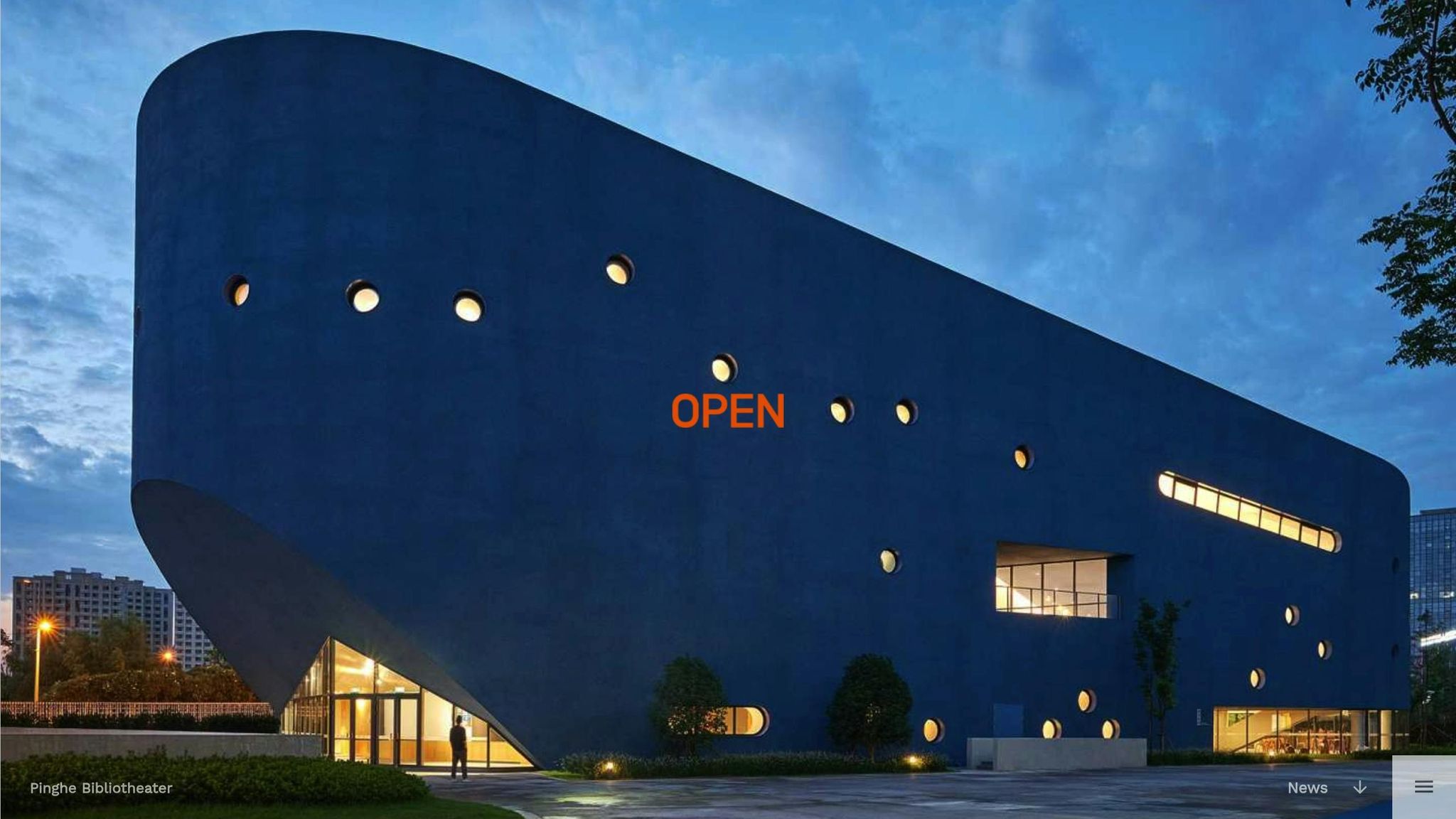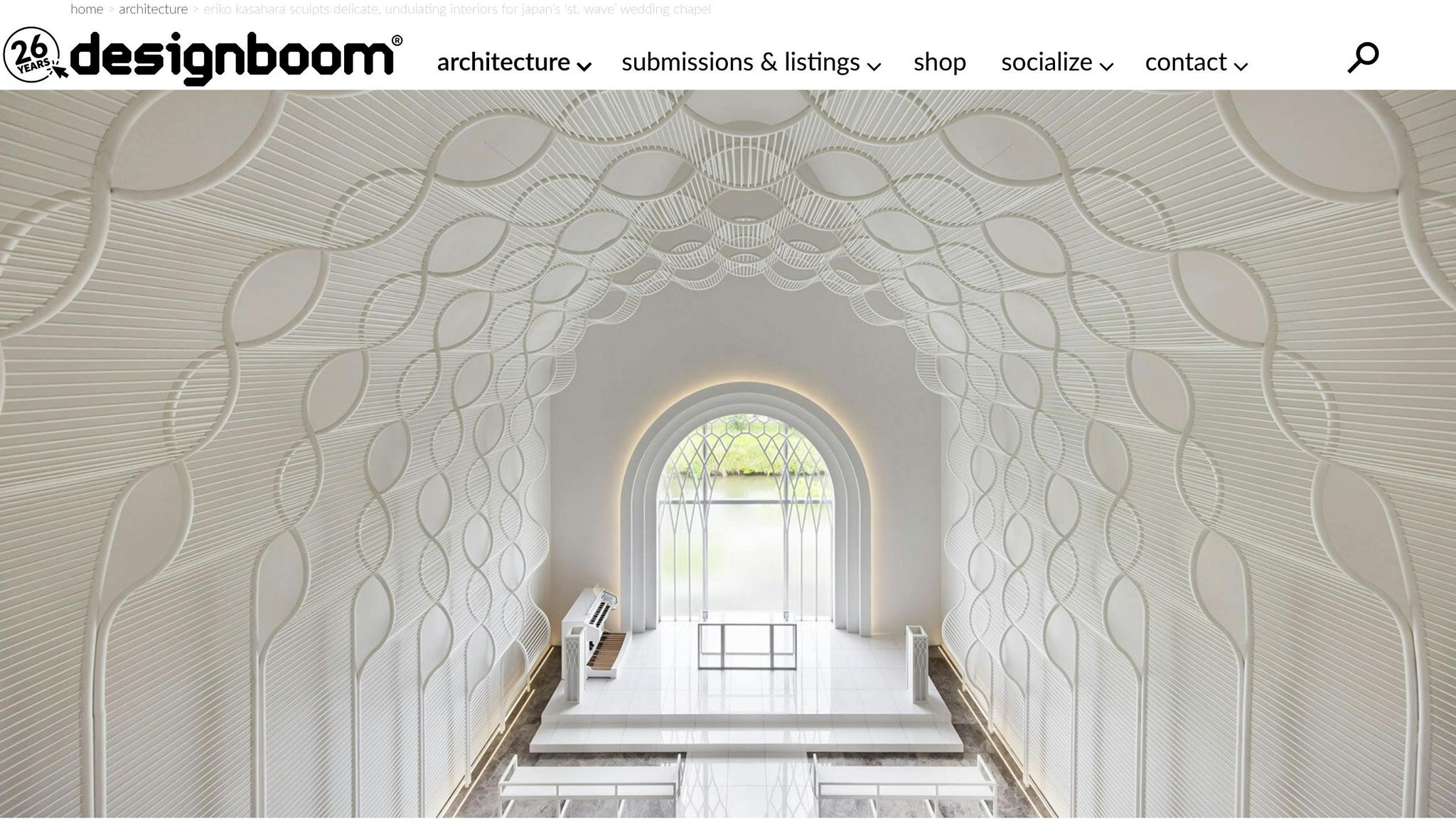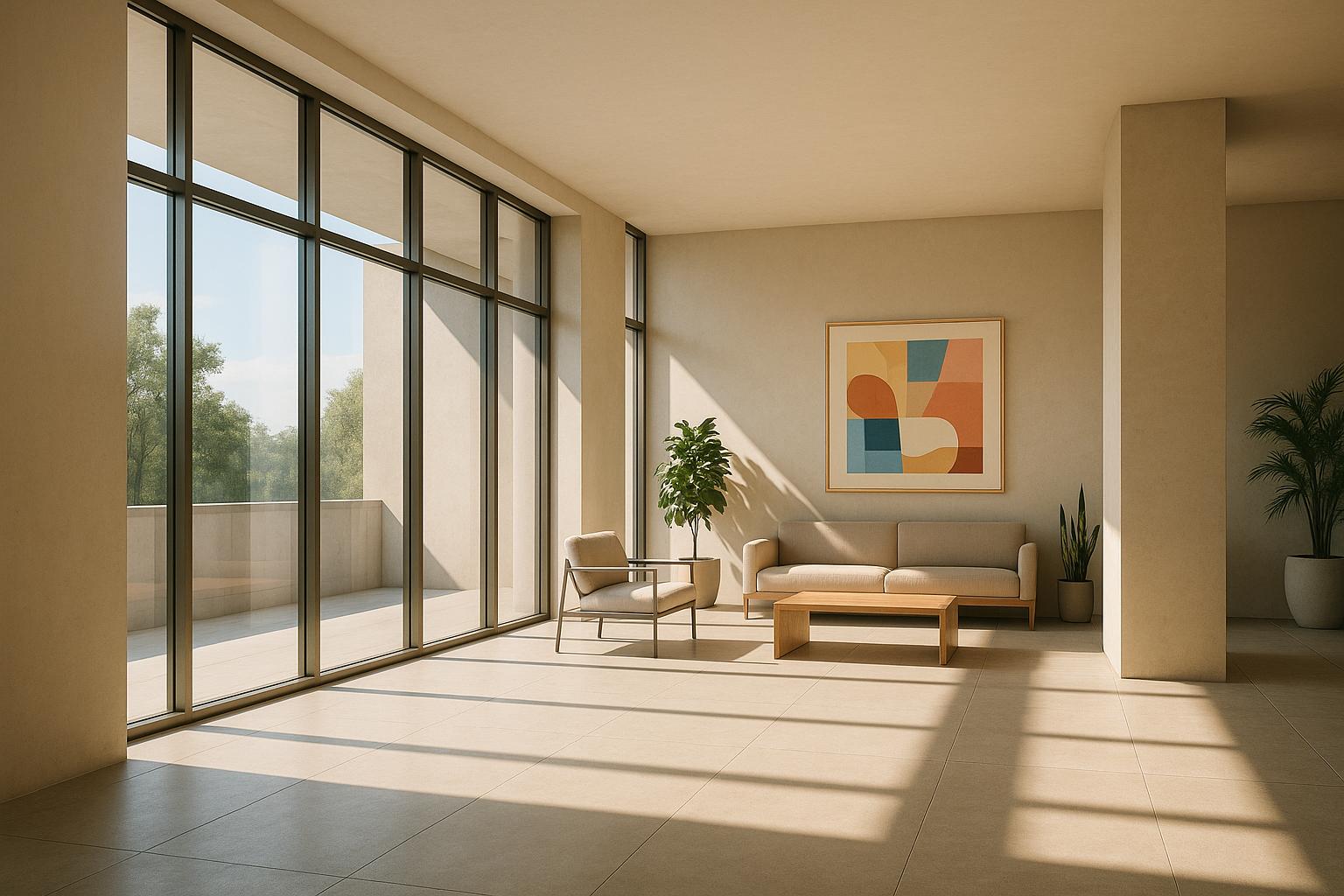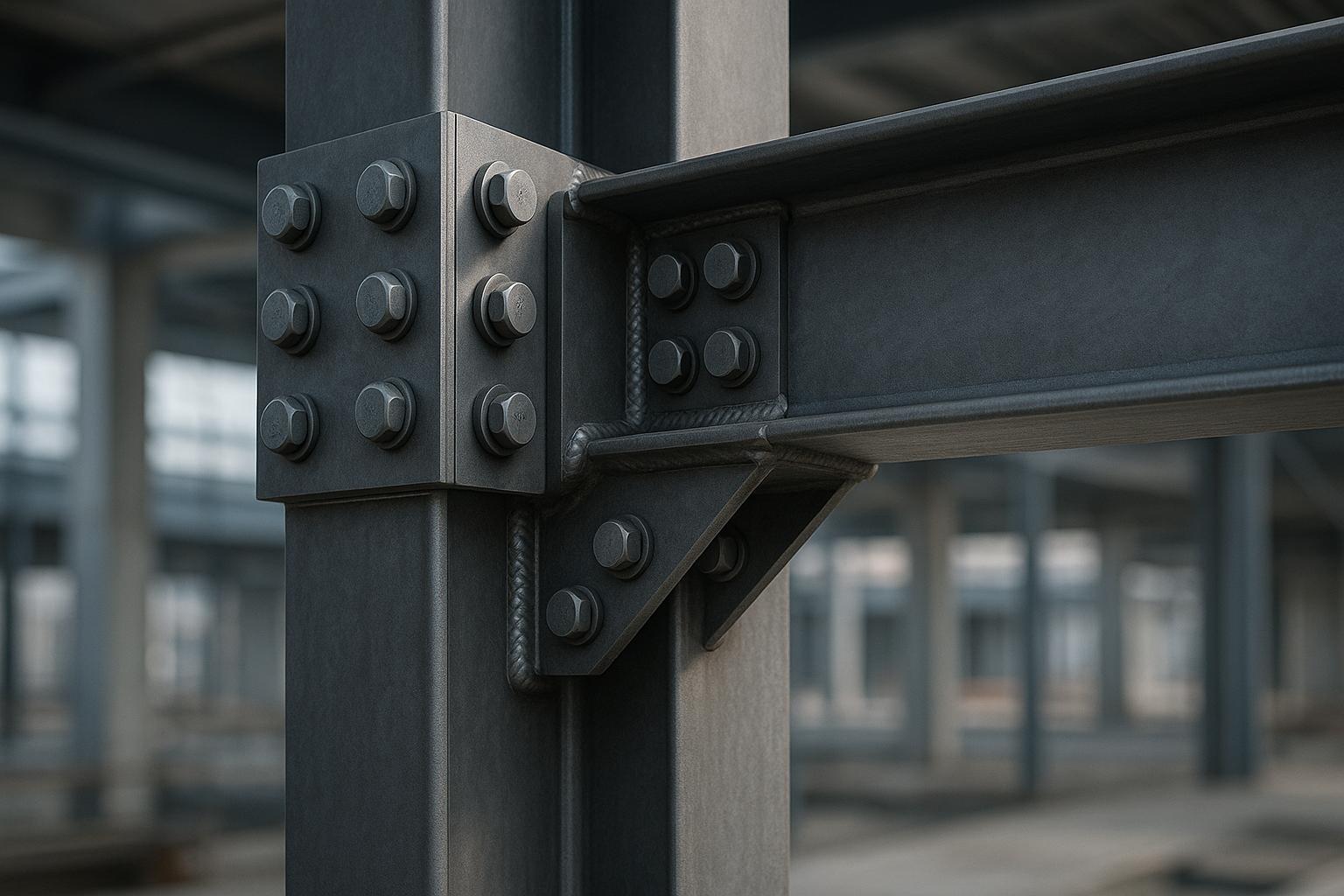Modern chapels are redefining how architecture can inspire spiritual experiences. These spaces combine bold designs with purposeful structural elements to evoke emotions like reverence and connection. Instead of relying on traditional forms, they use clean lines, natural light, and innovative materials to create sanctuaries that feel both contemporary and meaningful.
Key trends include:
- Minimalist architecture: Simple designs that let materials and structure take center stage.
- Natural light: Windows and openings that create dynamic interior lighting effects.
- Symbolic structures: Features like cantilevers and curves that convey spiritual themes.
- Eco-conscious materials: Locally sourced materials that integrate with their surroundings.
Two examples highlight these principles:
- Ribbon Chapel (Hiroshima, Japan): Features two intertwining spiral staircases that serve as the building's structural core, symbolizing unity.
- St. Wave Chapel (Koshigaya City, Japan): A steel-pipe frame resembling waves, paired with a contrasting flat roof and curved interior.
These chapels demonstrate how design can transform spaces into more than just places of worship - they become architectural expressions of faith and reflection.
OPEN Architecture presents The Chapel of Sound | The World Around Summit 2022

Current Trends in Modern Chapel Design
Modern chapel architecture is undergoing a transformation, moving away from traditional Gothic and Romanesque aesthetics to embrace bold, contemporary ideas. This shift focuses on reimagining how form and function can enhance spiritual experiences, blending creativity with purpose.
One prominent trend is the rise of minimalist design. Rather than relying on intricate decorations, architects are opting for clean lines and striking geometric shapes. The materials themselves - like concrete, steel, and glass - take center stage, creating spaces where simplicity speaks volumes. The absence of ornamentation allows the structure to evoke a sense of awe and reflection through its very essence.
Another hallmark of modern chapels is the innovative use of natural light. Sunlight is treated as an integral part of the design, with features like clerestory windows, strategically placed openings, and reflective surfaces. This interplay of light transforms interiors throughout the day, creating shifting atmospheres that deepen the worship experience. These designs often align with eco-conscious practices, incorporating energy-efficient lighting and passive cooling systems to reflect a commitment to sustainability.
The use of locally sourced materials further ties these chapels to their environments, emphasizing harmony with nature. At the same time, architects are exploring daring structural elements like cantilevers, flowing curves, and gravity-defying forms. These choices are not just visually striking - they often symbolize spiritual themes such as transcendence, unity, and the connection between the earthly and the divine.
What Makes Structural Features Stand Out
Modern chapels are redefining architectural expression by moving beyond traditional forms like spires and arches. Instead, they use structure itself as a powerful storytelling tool.
Cantilevers and overhangs are a striking example. These dramatic features create the illusion of weightlessness, evoking a sense of spiritual elevation. Achieving these designs requires close collaboration between architects and structural engineers, blending artistry with technical precision.
Curved and organic forms are also gaining popularity, enabled by advanced design tools. These shapes often draw inspiration from nature - mirroring elements like water, wind, or growth - and seamlessly connect the sacred space to the natural world.
Layering materials adds depth and meaning to chapel designs. By combining elements like glass, steel mesh, concrete, and wood, architects create rich visual textures that play with light and shadow. This approach fosters spaces that feel both expansive and intimate, encouraging contemplation and connection.
The integration of nature and architecture is another defining feature. Many chapels now include living walls, water features, or direct links to outdoor gardens. This blurring of boundaries between indoor and outdoor spaces creates a sense of unity with the surrounding environment, making the chapel feel like an extension of nature rather than a separate entity.
How We Selected These Chapels
Our selection highlights chapels that excel in minimalist design, creative use of light, and sustainable practices. Each chapel demonstrates how structural design can amplify its spiritual purpose while responding thoughtfully to its environment.
We focused on chapels that blend seamlessly with their surroundings, using materials and forms that reflect their local context. This ensures each building feels rooted in its location rather than appearing as a generic or disconnected design.
Symbolism played a crucial role in our evaluation. We prioritized chapels where structural elements enhance spiritual experiences - whether through light manipulation, contemplative spaces, or forms that convey religious themes.
Innovative construction techniques were another key factor. We looked for projects that push architectural boundaries, showcasing new ways to use materials and solve structural challenges while serving their communities.
Finally, we included chapels of varying scales and purposes - from small, intimate spaces to larger community hubs. This variety highlights how creative design can inspire worship across different contexts and budgets.
5 Modern Chapels with Distinct Structural Elements
Modern architecture has brought a fresh perspective to chapel design, blending creativity with structural ingenuity. Here are two standout examples:
Ribbon Chapel, Hiroshima, Japan
The Ribbon Chapel redefines traditional architectural norms with its two intertwining spiral staircases. These staircases do more than guide visitors - they act as the backbone of the entire structure, supporting roofs, eaves, walls, and floors. This unique three-dimensional hoop design efficiently manages both horizontal and vertical loads, eliminating the need for conventional beams. The design's brilliance has been widely recognized, earning prestigious awards like the JCD Award 2014 Grand Prize and the ArchDaily Building of the Year Award in Religious Architecture.
St. Wave Chapel, Koshigaya City, Japan

The St. Wave Chapel stands out with its freestanding steel-pipe frame, designed to mimic the motion of gentle waves. The structure’s eight spans create a dynamic, flowing exterior, while the flat roof and continuous walls provide a striking contrast to the softly curved ceiling inside. This harmonious blend of elements makes the chapel a captivating example of modern design.
sbb-itb-1be9014
Side-by-Side Analysis of Structural Elements
Examining select modern chapels reveals how thoughtful design choices shape spiritual spaces. These examples showcase how materials and spatial techniques come together to create deeply evocative environments.
Comparison Table
| Chapel Name | Location | Key Structural Feature | Material/Technique | Symbolism | Impact |
|---|---|---|---|---|---|
| Church of Light | Ibaraki, Japan | Rectangular main building with a cross-shaped cut in the east facade | Reinforced concrete (main structure), wood (flooring, pews) | "No light without darkness" (Ando's expression) | Minimalist concrete architecture amplifies the dramatic impact of light from the cross-shaped opening, creating a sacred atmosphere without excessive decoration. The use of wood fosters a connection to nature. Achieved on a modest budget. |
| Nova Serrana Chapel | Nova Serrana, Brazil | Tilted concrete walls on a concave-shaped plan, concave roof with slits | Bare concrete walls | Minimalist design aimed at tranquility | The bare concrete walls provide a serene, distraction-free environment. Roof slits create striking light effects, with sharp angles of sunlight illuminating the interior, enhancing the contemplative mood. |
These examples highlight how design translates into spiritual ambiance. The Church of Light uses a cross-shaped opening to turn a minimalist concrete structure into a sacred space filled with light and meaning, all while maintaining a low budget. Meanwhile, Nova Serrana Chapel achieves a tranquil atmosphere through angled concrete walls and precise natural light, encouraging quiet reflection in an uncluttered space.
Conclusion: How Structural Design Shapes Modern Chapels
Modern chapels are redefining sacred spaces by using structure as a form of expression. The architectural trends highlighted here reveal how thoughtful structural elements can transform chapels into spaces that not only serve spiritual purposes but also resonate with deeper theological meanings of permanence and transcendence.
One of the most notable shifts in chapel design is the focus on community-centered spaces. By incorporating multipurpose layouts, these chapels become more than just places of worship - they evolve into dynamic hubs for education, social interaction, and prayer ministries. Features such as flexible seating, intentional lighting, and well-planned acoustics enhance the sense of unity and encourage active participation, creating an environment where people can reflect, connect, and grow spiritually.
Inclusivity and accessibility are at the forefront of modern chapel design. Structural innovations like ramps, elevators, and open layouts ensure that chapels welcome individuals from all walks of life, regardless of physical ability or background. These thoughtful design choices help foster a sense of belonging and ensure that everyone can fully engage in the worship experience.
Sustainability is another driving force shaping chapel architecture. From the use of eco-friendly materials to integrating solar power systems and employing waste-reduction techniques like laser scanning during construction, these chapels demonstrate a commitment to responsible stewardship of the environment. These practices not only align with the values of creation care but also enhance the efficiency of the construction process.
For those interested in delving deeper into these architectural principles, Architecture Helper (https://architecturehelper.com) is a valuable resource. It offers tools for analyzing structural elements in religious spaces and provides a library of case studies that explore how design influences spiritual environments.
These five chapels illustrate how structural design goes beyond aesthetics - it becomes a medium for fostering community, enhancing worship, and connecting with the divine through intentional, well-crafted physical spaces.
FAQs
How do modern chapels use natural light to create a spiritual atmosphere?
Modern chapels frequently incorporate natural light as a central feature in their design, aiming to inspire a sense of spirituality and connection. Elements like skylights, cross-shaped openings, and detailed latticework allow sunlight to stream in, casting shifting patterns and accentuating the architectural features.
This intentional use of light does more than enhance aesthetics - it creates a peaceful, reflective atmosphere. By blending the built environment with the natural world, these spaces invite visitors to experience a deeper sense of calm and introspection.
How do eco-friendly materials influence the design of modern chapels?
Eco-Friendly Materials in Modern Chapel Design
Eco-friendly materials are transforming the way modern chapels are designed, emphasizing sustainability and care for the environment. Many chapels now feature natural materials like wood and stone, valued for their minimal environmental impact and timeless appeal. Beyond that, recycled or reclaimed elements - such as steel, glass, and certified sustainable wood - are frequently used to cut down on waste and support greener construction practices.
By using these materials, chapels not only reduce their ecological footprint but also align with modern values of living in harmony with nature. The result? Spaces that are as visually stunning as they are environmentally conscious.
How do features like cantilevers and curves reflect spiritual themes in modern chapel design?
Modern chapels have embraced cantilevers and curves as powerful design elements to convey spiritual themes in fresh, meaningful ways. Cantilevers, with their striking extensions, often symbolize an upward reach, reflecting humanity's aspiration toward a higher spiritual realm. On the other hand, curves bring a sense of fluidity and unity, embodying harmony, grace, and the winding path of faith.
These architectural choices help create spaces that are both uplifting and tranquil, inviting moments of quiet reflection and a stronger connection to the divine. By merging bold structural design with rich symbolism, modern chapels leave visitors inspired and contemplative.


